“Colors and Shadows: Hot Mess Formalism Review” by Shannon Ludington
December 6, 2017
Sheila Pepe: Hot Mess Formalism at the Phoenix Art Museum is the first mid-career review of Sheila Pepe’s work. The exhibit was curated by the Selig Family Chief Curator Gilbert Vicario and includes Pepe’s signature yarn installations as well as drawings, video, and votive works in a variety of media. It is exciting to see the breadth of Pepe’s work, but what is most thrilling is the new textile work commissioned for the exhibit that highlights her masterful use of space and interest in flip-flopping expectations of high and low, artist and maker.
The show is introduced by a wall text and a selection of Pepe’s early work. Most notable is Women Are Bricks (Mobile Bricks) first made in 1983 and recreated for this exhibit. It consists of triangular handmade bricks resting on small cement rollers on a flowered carpet. The piece sits in front of a white wall, confronting it; the proportions of the piece and closeness to the floor challenge our expectations of how to interact with work in a museum. The overall composition references a Leavittown neighbourhood and the overlooked feminine labour that goes on inside of the homes in contrast to materials often perceived as masculine
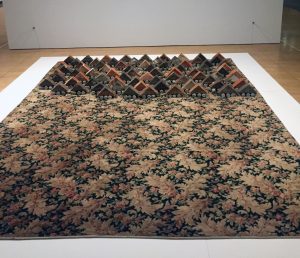
Sheila Pepe Women Are Bricks (Mobile Bricks) 1983 (remade 2017), handmade bricks, rug, cement.
The magic of Hot Mess Formalism is in Pepe’s unerring color sense and use of space. On the wall backing Women Are Bricks (Mobile Bricks) is Second Council Vatican Wrap, a large purple knitted form reaching up several stories and sliding onto the floor. From the top of the piece stretches a canopy of gold yarn crisscrossing over and into the next gallery area which features the newest piece, commissioned by the museum for this exhibit, 91 BCE 
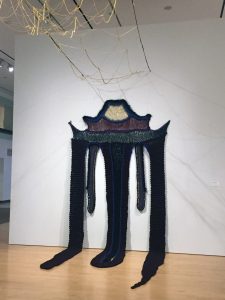
Sheila Pepe Second Vatican Council Wrap 2013, synthetic and natural yarn, metallic thread.
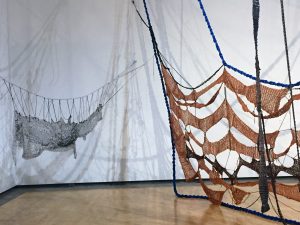
Sheila Pepe 91 BCE 
The gallery space, though it has several large white walls, also has features which could be visually distracting—a dark elevator, floating stairs, and uneven wall heights. In previous exhibits I have seen here, the work has competed with these features. Here it is integrated. Every move throughout the space brings to light a new detail, a new visual delight that Pepe has carefully thought out.
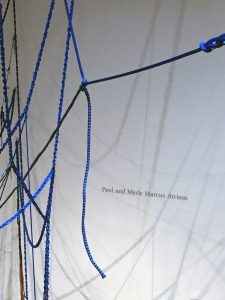
Sheila Pepe 91 BCE 
As one moves up the open stair to see the rest of the exhibit and the view of 91 BCE 
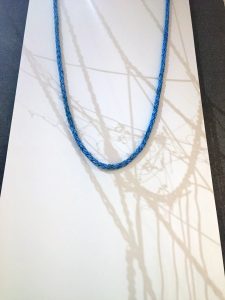
Sheila Pepe Red Hook at Bedford Terrace (detail) 2008, shoelaces, cotton yarn, nautical towline.
On the third floor overlooking the gallery with 91 BCE 
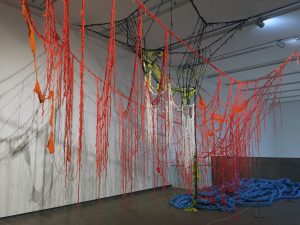
Sheila Pepe Red Hook at Bedford Terrace (installation) 2008, shoelaces, cotton yarn, nautical towline.
Hot Mess Formalism could not exist without the number of museum staff and volunteers that helped physically bring it into being. Ceramics students from Arizona State University fired the bricks for Women Are Bricks and Pepe worked with large numbers of museum docents and staff to install the show. To create 91 BCE 
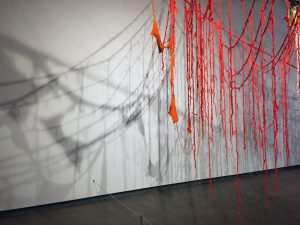
Sheila Pepe Red Hook at Bedford Terrace (detail) 2008, shoelaces, cotton yarn, nautical towline.
It is exciting to see Pepe being introduced to a new audience in the South West and to be able to trace her career and thought processes through this variety of work. The show will move on to the Everson Museum of Art in Syracuse, New York in 2018, and I encourage everyone in the area to see it.
– Shannon Ludington

Related Blog Articles
No Thumbnail Available
Art vs. Craft
Symposium Review: “Trace Evidence” @NCSU/Raleigh